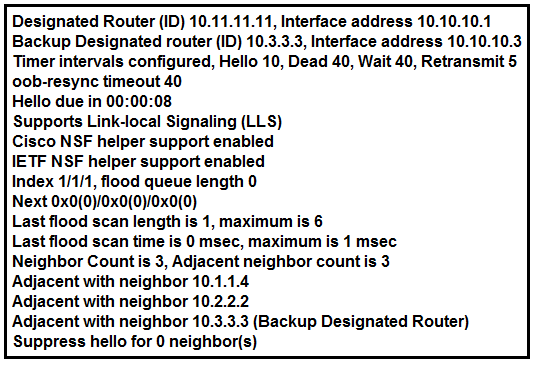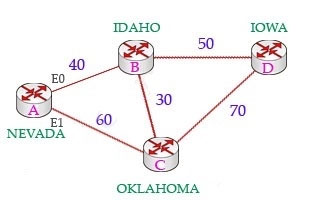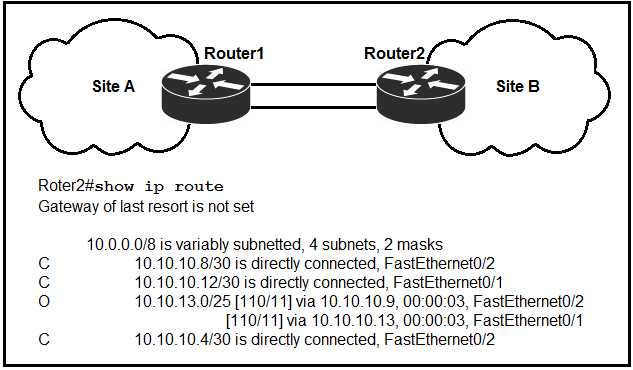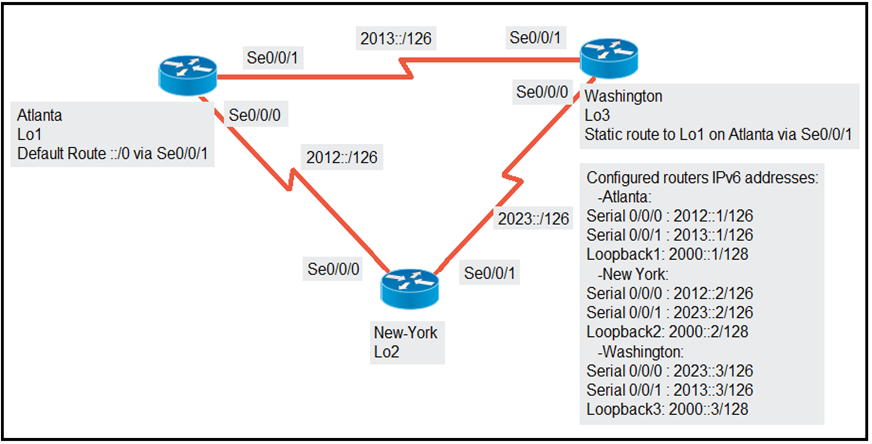When a floating static route is configured, which action ensures that the backup route is used when the primary route fails?
D

Refer to the exhibit. The show ip ospf interface command has been executed on R1. How is OSPF configured?
C
From the output we can see there are Designated Router & Backup Designated Router for this OSPF domain so this is a broadcast network (point-to-point and point-to-multipoint networks do not elect DR & BDR).
By default, the timers on a broadcast network (Ethernet, point-to-point and point-to-multipoint) are 10 seconds hello and 40 seconds dead. The timers on a non- broadcast network are 30 seconds hello 120 seconds dead.
From the line ג€Neighbor Count is 3ג€, we learn there are four OSPF routers in this OSPF domain.
Reference:
https://www.cisco.com/c/en/us/support/docs/ip/open-shortest-path-first-ospf/13689-17.html
A user configured OSPF and advertised the Gigabit Ethernet interface in OSPF. By default, to which type of OSPF network does this interface belong?
C
The Broadcast network type is the default for an OSPF enabled ethernet interface (while Point-to-Point is the default OSPF network type for Serial interface with
HDLC and PPP encapsulation).
Reference:
https://www.oreilly.com/library/view/cisco-ios-cookbook/0596527225/ch08s15.html
Which attribute does a router use to select the best path when two or more different routes to the same destination exist from two different routing protocols?
C
Administrative distance is the feature used by routers to select the best path when there are two or more different routes to the same destination from different routing protocols. Administrative distance defines the reliability of a routing protocol.
Router A learns the same route from two different neighbors; one of the neighbor routers is an OSPF neighbor, and the other is an EIGRP neighbor.
What is the administrative distance of the route that will be installed in the routing table?
B
The Administrative distance (AD) of EIGRP is 90 while the AD of OSPF is 110 so EIGRP route will be chosen to install into the routing table.

Refer to the exhibit. An engineer is bringing up a new circuit to the MPLS provider on the Gi0/1 interface of Router 1. The new circuit uses eBGP and learns the route to VLAN25 from the BGP path.
What is the expected behavior for the traffic flow for route 10.10.13.0/25?
D
The AD of eBGP (20) is smaller than that of OSPF (110) so the route to 10.10.13.0/25 will be updated as being learned from the new BGP path.
Which two actions influence the EIGRP route selection process? (Choose two.)
BD
The reported distance (or advertised distance) is the cost from the neighbor to the destination. It is calculated from the router advertising the route to the network.
For example in the topology below, suppose router A & B are exchanging their routing tables for the first time. Router B says ג€Hey, the best metric (cost) from me to IOWA is 50 and the metric from you to IOWA is 90ג€ and advertises it to router A. Router A considers the first metric (50) as the Advertised distance. The second metric (90), which is from NEVADA to IOWA (through IDAHO), is called the Feasible distance.
The reported distance is calculated in the same way of calculating the metric. By default (K1 = 1, K2 = 0, K3 = 1, K4 = 0, K5 = 0), the metric is calculated as follows:
Feasible successor is the backup route. To be a feasible successor, the route must have an Advertised distance (AD) less than the Feasible distance (FD) of the current successor route.
Feasible distance (FD): The sum of the AD plus the cost between the local router and the next-hop router. The router must calculate the FD of all paths to choose the best path to put into the routing table.
Note: Although the new CCNA exam does not have EIGRP topic but you should learn the basic knowledge of this routing protocol.

Refer to the exhibit. If OSPF is running on this network, how does Router2 handle traffic from Site B to 10.10.13.128/25 at Site A?
D
Router2 does not have an entry for the subnet 10.10.13.128/25. It only has an entry for 10.10.13.0/25, which ranges from 10.10.13.0 to 10.10.13.127.
Which two outcomes are predictable behaviors for HSRP? (Choose two.)
AE

Refer to the exhibit. An engineer is configuring the New York router to reach the Lo1 interface of the Atlanta router using interface Se0/0/0 as the primary path.
Which two commands must be configured on the New York router so that it reaches the Lo1 interface of the Atlanta router via Washington when the link between
New York and Atlanta goes down? (Choose two.)
AE
Floating static routes are static routes that have an administrative distance greater than the administrative distance (AD) of another static route or dynamic routes.
By default a static route has an AD of 1 then floating static route must have the AD greater than 1. Floating static route has a manually configured administrative distance greater than that of the primary route and therefore would not be in the routing table until the primary route fails.